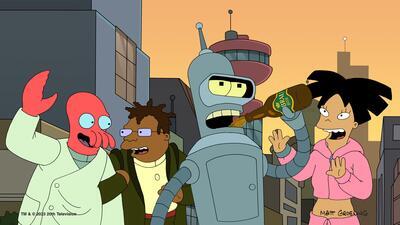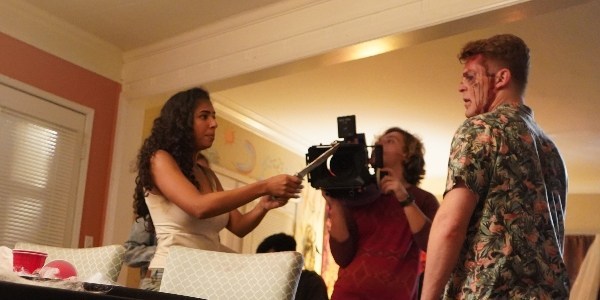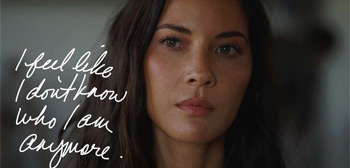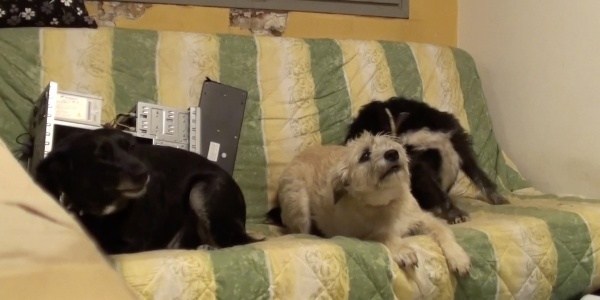SYMBIOPSYCHOTAXIPLASM: TAKE ONE: Documentary Unraveled
“This is terrible!” says the director, appearing onscreen for the first time after the sequence of haphazardly shot, the off-kilter dialogue of the opening minutes of the film. Only the first delightful surprise of experimental fiction-documentary Symbiopsychotaxiplasm, this unexpected commentary sets the stage for a spectacular and very odd 75 minutes.
A Bad Idea?
Symbiopsychotaxiplasm: Take One begins with what appears to be a very messy film production simultaneously inhabiting its shooting and brainstorming phases. We follow actors and crew through seemingly insignificant action, excessive takes, and improvisational directions. Scenes are shot multiple times in different places with multiple actors. There are three camera operators who film the actors, the crew, and each other.
The crew follows the actors and director as they try to build a film. William Greaves, the director, and editor gives us as much information as possible while speaking through the medium itself. He leaves in different angles of the same action, camera directions, conversations with actors, and even notes to the editor spoken over problematic footage.

As some of the crew become frustrated with this incredibly odd style of direction, we find ourselves in a studio as they film themselves without the director’s knowledge. They criticize the film, debating among themselves whether Greaves is incompetent or a chaotic mastermind. Did he intend to create conflict? Is he commenting on the banality of life? Is he playing a part in his own film, as one member comments, changing his persona with the cameras even as the director?
Welcoming Anarchy
This miniature rebellion changes the course of the experiment as the crew takes their grievances to the director. Didn’t they read the concept, he asks? “The screen test proves to be unsatisfactory to the actors … and then the actors and the director undertake to improvise something better.”
Greaves wants the crew and actors to use their collective creativity to create a valuable piece of art, intending himself to stand for the establishment, and they the rebellious youth who, disenchanted, must discover the power of collective action. They begin to experiment in earnest, actors even singing lines to achieve a more genuine performance. They engage passersby from their shooting location in Central Park, the film focusing more closely on these unscripted interactions than on the actors.

The film ends much as it began, but this time without its façade. The crew, actors, and director have dived into uncertainty and experimentation — all on the same page, now — and they appreciate if not revel in the unconventional final project.
Common People
Greaves, rather than playing the typical director to his film, masterminded a creative coup. He trusted his crew to create something together that he alone could not, believing in this symbiotic piece of art above anything he personally intended. But this is only one facet of Greaves‘ concern with people throughout the entire film. He takes great interest in the minutia of interactions between the crew, off-script actors, and even — especially — bystanders.
Symbiopsychotaxiplasm‘s last and perhaps most poignant interaction is with a candid, philosophical man the crew meets in the park. It is beyond me what drew Greaves to the personalities he chose to highlight, but in this man perhaps he saw the same grounded revolutionary that he attempted to provoke in his crew throughout filming.

When they begin to leave, the man says, “I never say goodbye. I like to say so long.” He walks with them for a moment before departing, saying, “I never say goodbye. I like to say ciao.” The humanity in these small interactions is flooring after an hour of amusing and somewhat unserious chaos.
A Bird’s-Eye View
When the film ends, we are left still wondering. Did Greaves intend this end product from the beginning? Did his vision change after seeing the raw (and, presumably, wildly extensive) footage? Did he even have an initial vision?
And even so, Greaves tells us through his own editing what he intended, or at least, ended up intending. His editing obfuscates the “initial” film entirely. Instead, we see a production of people investigating each other and themselves, in service not of narrative but experiment. We are given as close to omniscience through editing and direction as Greaves can manage.
In this omniscience, we see more coherent of a story than probably anyone, in particular, had while filming. It speaks to Greaves‘ ingenuity that he not only predicted these dynamics but was able to guide them into existence. As such, Symbiopsychotaxiplasm stands in homage to the unanticipated and the experimental, unraveling the form of cinema and documentary with its unique and delightful construction.
What do you think is the nature of film and documentary? Are you intrigued or frustrated by this style of experimentation? Let us know in the comments!
Symbiopsychotaxiplasm: Take One is available to stream on The Criterion Channel.
Watch Symbiopsychotaxiplasm: Take One
Does content like this matter to you?
Become a Member and support film journalism. Unlock access to all of Film Inquiry`s great articles. Join a community of like-minded readers who are passionate about cinema – get access to our private members Network, give back to independent filmmakers, and more.
Join now!





